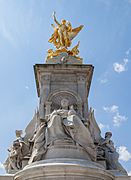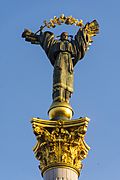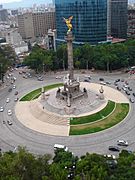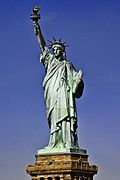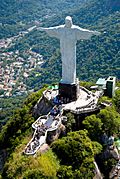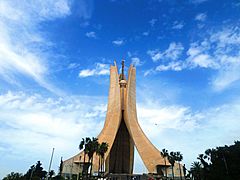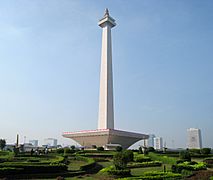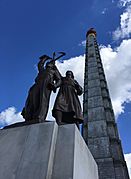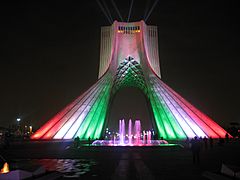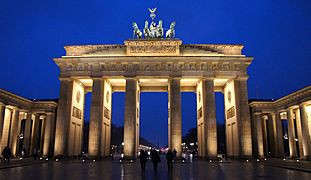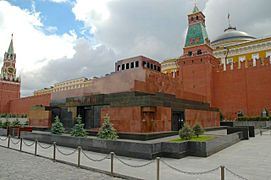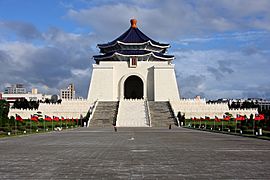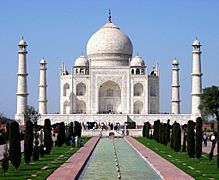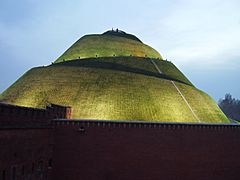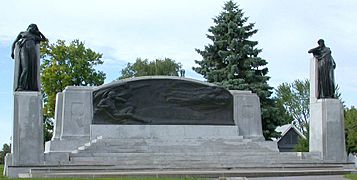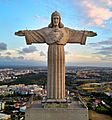Monument facts for kids

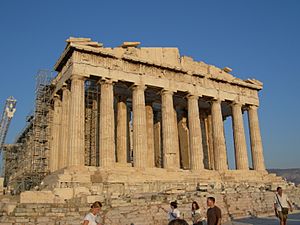
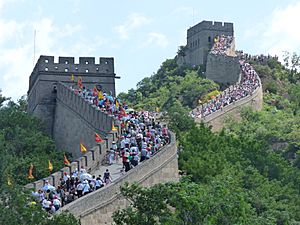

A monument is a special structure built to remember a person, an event, or an important idea. Think of them as giant reminders! They can be statues, memorials, old buildings, or even ancient sites. Monuments are important because they show us history, art, and culture. Sometimes, a monument is so important that it becomes a UNESCO World Heritage Site. This means it is protected for everyone to enjoy and learn from.
Contents
What Does the Word "Monument" Mean?
The word "monument" comes from old Greek and Latin words like mnemosynon and moneo. These words mean 'to remind' or 'to warn'. So, a monument helps us remember the past. It can also help us think about the future. When something is called "monumental," it often means it is very big and powerful.
Why Are Monuments Built?
People have been building monuments for thousands of years. They are often the most lasting symbols of old civilizations. For example, ancient Egyptians built huge Pyramids. The Greeks built the Parthenon. The Great Wall of China is another massive monument. These structures became symbols of their civilizations.
In more recent times, monuments like the Statue of Liberty and the Eiffel Tower have become symbols of modern countries. Monuments are also often used to make cities look better. Cities like Washington, D.C. are even designed around their monuments. The Washington Monument, for instance, helps organize the public spaces in the city.
Sometimes, a building or structure becomes a monument over time. This happens if it is very old, very big, or has a lot of historical meaning.
Different Kinds of Monuments
There are many different types of monuments around the world. Here are some examples:
- Benchmarks are markers placed by governments. They help with surveying land.
- Buildings can be monuments if they are landmarks. They might be the tallest or most unique buildings. An example is the Burj Khalifa in Dubai.
- Cenotaphs are memorials for people buried somewhere else. They often honor soldiers who died in wars. The India Gate is an example.
- Church monuments are found in churches. They remember people who have passed away.
- Columns are tall pillars. They often have a statue on top. Nelson's Column in London is a famous one.
- Eternal flames burn all the time. They usually honor unknown soldiers. You can see one at the Tomb of Unknown Soldier in Moscow.
- Fountains are water structures. They are often in gardens or town squares. The Gardens of Versailles have many beautiful fountains.
- Gravestones are small monuments at gravesites. They honor the person buried there.
- Mausoleums and tombs are buildings built to honor the dead. The Taj Mahal is a famous mausoleum.
- Monoliths are single large stones. They are set up for religious or memory reasons. Stonehenge is a well-known example.
- Mosque Monuments are places of worship. They often have domes and minarets that stand out. They also feature beautiful art.
- Mounds are hills built to remember leaders or events. The Kościuszko Mound in Poland is an example.
- Obelisks are tall, thin, four-sided pillars. They often honor great leaders. The Washington Monument is the world's tallest obelisk.
- Palaces are grand royal homes. They are designed to show power and importance. The Palace of Versailles is a famous palace.
- Searchlights project strong beams of light. The Tribute in Light in New York City remembers the September 11 attacks.
- Statues are sculptures of famous people or symbols. The Statue of Liberty is a symbol of freedom.
- Temples or religious structures are built for worship or remembrance. Borobudur in Indonesia is a large temple.
- Terminating vistas are monuments placed at the end of a long street. The Opera Garnier in Paris is an example.
- Triumphal arches celebrate military victories. The Arc de Triomphe in Paris is a famous one.
- War memorials remember those who died in wars. The Iwo Jima Memorial is a well-known war memorial.
Famous Monuments Around the World
-
Victoria monument in London, a memorial to Queen Victoria of the British Empire
-
The Statue of Liberty, the symbol of the United States' freedom
-
The Cristo Redentor, a modern religious monument in Brazil
-
The Maqam Echahid, in Algiers, iconic concrete monument commemorating the Algerian war for independence
-
The Eiffel Tower, in Paris, a monument commemorating the French Revolution for its centenary
-
Monas in Jakarta, commemorates the Indonesian struggle for independence
-
The Juche Tower, a symbol of North Korea's "self reliant" Juche political stance
-
Azadi tower in Tehran, commemorates the 2,500 years of the Persian Empire and the history of Iran
-
Brandenburg Gate in Berlin, national symbol of Germany and its unity
-
Lenin mausoleum in Moscow, an enduring symbol of Soviet Union Communism and Cold War
-
The Chiang Kai-shek Memorial in Taipei is a monument to honor Chiang Kai-shek
-
The Cathedral of Santiago de Compostela where Saint James is buried
-
Kościuszko Mound, Poland commemorates Tadeusz Kościuszko
-
The Bell Telephone Memorial, commemorates the invention of the telephone, Brantford, Ontario
-
The Hiroshima Cenotaph and Atomic Bomb Dome to remember the victims of August 6, 1945 atomic bombing
Images for kids
-
The Monument to Nicholas I from Saint Isaac's Square in Saint Petersburg (Russia)
-
The Colosseum Flavian amphitheatre in Rome, a popular monument of the Roman Empire.
-
The Christ the King, in Almada, Portugal, has become one of the most visited national monuments.
-
The Washington Monument in Washington, D.C., which honors the first president of the United States, George Washington, is the world's tallest obelisk.
-
Christ the Redeemer, a modern religious monument in Brazil
-
Brisbane City Hall, national symbol of democracy
-
Chairman Mao Memorial Hall is located on the Tiananmen Square, where the Beijing Gate of China used to stand
-
The Cathedral of Santiago de Compostela where Saint James is buried
-
The Lincoln Memorial in Washington, D.C. honors American President Abraham Lincoln
See also
 In Spanish: Monumento para niños
In Spanish: Monumento para niños




